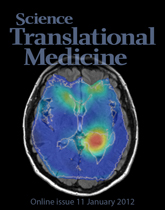Targeting IDH1 in Glioma Patients
One of the challenges of the next decade in cancer research will be targeting cancer metabolism; imaging is likely to play a key role in drug development.
 The cover of the January 11 online issue of Science Translational Medicine (STM) shows a brain tumor (glioma) in red, detected using non-invasive nuclear magnetic resonance imaging that highlights cancer metabolism.
The cover of the January 11 online issue of Science Translational Medicine (STM) shows a brain tumor (glioma) in red, detected using non-invasive nuclear magnetic resonance imaging that highlights cancer metabolism.
In a paper published in STM, Andronesi and colleagues from Harvard & other Cambridge, MA institutions (including Agios Pharmaceuticals – more on them later), showed that excess production of the metabolite 2-hydroxyglutarate (2HG) could be used as a biomarker for a subset of glioma.
The subset this metabolic biomarker identified, were those patients with mutations of the isocitrate dehyrogenase gene (IDH1), present in 86% of the grade II & III gliomas and secondary glioblastomas.
 Agios Pharmaceuticals founded by eminent cancer researchers, Lewis Cantley, Tak Mak and Craig Thompson is targeting the IDH1 and IDH2 metabolic pathways.
Agios Pharmaceuticals founded by eminent cancer researchers, Lewis Cantley, Tak Mak and Craig Thompson is targeting the IDH1 and IDH2 metabolic pathways.
They have shown that mutations of the metabolic gene IDH1 are consistent with that of a cancer-causing oncogene. Interestingly, Agios notes on their website that IDH1 and IDH2 mutations have also been seen in acute myeloid leukemia (AML).
What makes 2HG a functional biomarker for glioma is its correlation with survival. 2HG accumulates in the brains of patients with IDH1 mutations. These patients have a greater survival than those with wild-type IDH1 gliomas.
Developing a drug that targets cancer metabolism in the brain is not easy. NMR imaging of the 2HG in the brain will help researchers non-invasively follow the effects of inhibitors of mutated IDH1. This is particularly important given that, according to Andronesi et al, “no report exists about increased D-2HG in the blood, cerebrospinal fluid, or urine of glioma patients with IDH1 mutations.”
The January 11 online issue of STM, also contains another paper on the detection of 2HG using NMR. Elkhaled and colleagues from UCSF report a technique of proton high-resolution magic angle spinning spectroscopy. Their data confirms the potential of 2HG as a surrogate marker of patient survival.
Cancer metabolism as a drug development target is an area I expect we will see more of in the next ten years. Key to success will be the ability to identify biomarkers with which to assess and monitor the success of drug candidates.
The identification of 2HG as a biomarker for IDH1 in glioma patients shows that cancer metabolism is an area of potential for drug development.
One cloud on the horizon for Agios Pharmaceuticals is, however, the filing of a lawsuit late last year by the Abramson Cancer Institute of the University of Pennsylvania. This alleges that Craig Thompson concealed the start-up of Agios while working for Penn, and in essence took the intellectual property of the University to the company. The merits of this claim have yet to be decided.
References
![]() Andronesi, O., Kim, G., Gerstner, E., Batchelor, T., Tzika, A., Fantin, V., Vander Heiden, M., & Sorensen, A. (2012). Detection of 2-Hydroxyglutarate in IDH-Mutated Glioma Patients by In Vivo Spectral-Editing and 2D Correlation Magnetic Resonance Spectroscopy Science Translational Medicine, 4 (116), 116-116 DOI: 10.1126/scitranslmed.3002693
Andronesi, O., Kim, G., Gerstner, E., Batchelor, T., Tzika, A., Fantin, V., Vander Heiden, M., & Sorensen, A. (2012). Detection of 2-Hydroxyglutarate in IDH-Mutated Glioma Patients by In Vivo Spectral-Editing and 2D Correlation Magnetic Resonance Spectroscopy Science Translational Medicine, 4 (116), 116-116 DOI: 10.1126/scitranslmed.3002693
Elkhaled, A., Jalbert, L., Phillips, J., Yoshihara, H., Parvataneni, R., Srinivasan, R., Bourne, G., Berger, M., Chang, S., Cha, S., & Nelson, S. (2012). Magnetic Resonance of 2-Hydroxyglutarate in IDH1-Mutated Low-Grade Gliomas Science Translational Medicine, 4 (116), 116-116 DOI: 10.1126/scitranslmed.3002796
One Response to “Targeting IDH1 in Glioma Patients”
Nice summary! The link to Grade IV gliomas is also intersting: IDH mutations are rarely, if ever, found in primary glioblastoma (for example) while being more frequent in the secondary type, which is usually derived from lower-grade gliomas. Mutations in IDH appear to be one of the factors that allows separation of primary and secondary Grade IV gliomas into two distinct types of disease.
Comments are closed.